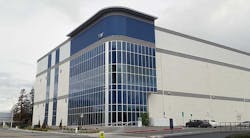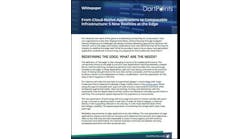Supply Cycles Guide Data Center Leasing in Silicon Valley
We continue our series of stories on the leading geographic markets for data center space with a report on the Silicon Valley Data Center Market. Data Center Frontier is partnering with DatacenterHawk to provide in-depth market reports on each city we profile. This post focuses on Silicon Valley data center market supply trends.
Download the full report.
With a vacancy rate of just 7.8 percent, Silicon Valley has a limited supply of large data center footprints. The market has absorbed 35 to 40 megawatts of demand annually in recent years. Absorption was above average in 2016 and noticeably lower in 2017 due to restricted supply. Estimates vary, depending on the timing of deals in late 2016 and early 2017, with JLL placing the wholesale leasing volume at just 10 MW for 2017.
The vacancy rate for available space has remained low, as seen in the chart below from datacenterHawk.
That strong demand has paved the way for new construction, with Vantage Data Centers, Equinix and Digital Realty all expanding their data center footprints in Silicon Valley.
Here’s an overview of recent deliveries and ongoing construction:
- Vantage delivers V6, nears opening for V5: In October Vantage Data Centers opened its newest Silicon Valley data center, known as V6. The two-story, 9 MW building is almost fully leased already. Additionally, Vantage is nearing completion on V5, which will house 15 MW when fully delivered and is anticipated to come online in early 2018. V5 will offer a range of power densities, as well as variable resiliency space with less elaborate backup power infrastructure than traditional data centers.
- Vantage also is developing a 9-acre site on Mathew Street in Santa Clara as a major new cloud campus, which will be home to four data centers offering 69 megawatts of critical IT load. The first facility is projected to be completed in the first half of 2019.
- Digital Realty Readies New Building: In 2Q 2017, Digital Realty began construction on 3205 Alfred Street, a new two-story, 6 MW data center. The company will invest $75 million in the project, which is scheduled for delivery in the first quarter of 2018.
- CoreSite procures expansion site: CoreSite has completed its acquisition of a two-acre site directly north of its existing Santa Clara campus. Entitlement work is underway. And development on the site is scheduled to begin in the first half of 2018. CoreSite plans to build a 160,000 SF data center that can support 18 megawatts of additional capacity.
- Equinix Expands in San Jose: In September, Equinix completed the first phase of its SV10 data center in southern San Jose. The facility features approximately 3.6 MW of commissioned power and has the ability to add 10.8 MW of commissioned power as demand presents itself.
A development worth watching is the recent announcement that Equinix will pursue larger deals with hyperscale providers, which means it may compete with wholesale players on deals of 1 MW to 5 MW. This has significance in Santa Clara, where Equinix now owns the former Terremark campus on Corvin Drive, which it purchased from Verizon in December 2016. Equinix can use available capacity on that campus for either colo or hyperscale deals.
At the close of the third quarter, there was 15 MW of capacity under construction in Silicon Valley, compared to 27.85 MW in the second quarter of 2016, according to datacenterHawk.
As previously noted, construction volume in Silicon Valley trails well behind other major U.S. data center markets. There is currently 43 MWs under construction in Northern Virginia and 29 MWs being built in the Chicago market.
In our Fall 2016 report we noted that wholesale providers were reporting stronger pricing on their inventory in Silicon Valley. As noted earlier, this trend now extends beyond individual providers and is showing up in market-wide data for larger requirements.
The History of Silicon Valley Data Center Market Supply Cycles
The supply of data center space in Silicon Valley has fluctuated over the years, including a building frenzy during the dot-com boom that was followed by the bankruptcies of key players (notably Exodus, which built multiple data centers in Santa Clara).
In 2008-10 Santa Clara emerged as a significant market for wholesale data center space, with Facebook leasing large footprints from multiple providers in Silicon Valley. In 2011 the market got three new players as DuPont Fabros, Vantage and Server Farm Realty opened new data centers.
The market shifted in early 2013, absorbing new supply even as Facebook announced plans to sublease its third-party space in Silicon Valley and migrate capacity to its company-built data center in Oregon. The inventory of sub-leases and newly-built space took some time to digest, but ultimately demonstrated the resiliency of the Silicon Valley market.
As we enter 2018, supply in Silicon Valley will be increasingly defined by providers’ ability to add capacity and acquire additional land. The most aggressive expansion effort is the Vantage Data Centers project on Mathew Street in Santa Clara, which in 2019 will commence offering four data centers and 69 MW of power.
Digital Realty has the largest footprint in Santa Clara but has not announced any expansion sites beyond the 6 MW currently under development at 3205 Alfred. The company has a history of acquiring properties adjacent to its connectivity hub on Space Park Drive and converting them to data center use.
Another provider that has not announced local expansion plans is QTS, which has limited capacity in its two Santa Clara data centers. These are among the sites offering colocation through a partnership with Amazon Web Services, with space pre-configured to connect to the AWS cloud. The company recently announced plans to build a greenfield “mega data center” project on a 92-acre site in Hillsboro, Oregon. Given its historic focus on disciplined capital allocation, it is unclear if QTS will seek to expand in Silicon Valley or focus on opportunities in Oregon. The success of QTS’ partnership with AWS will likely be a factor in its strategy.
[clickToTweet tweet=”In 2018, data center supply in Silicon Valley will be increasingly defined by providers’ ability to add capacity and acquire additional land. ” quote=”In 2018, data center supply in Silicon Valley will be increasingly defined by providers’ ability to add capacity and acquire additional land. “]
A number of providers have expressed interest in entering the Silicon Valley market. In October 2016, CyrusOne announced its intent to add a data center in the Santa Clara market, but has offered no details yet on its plans. RagingWire Data Centers and Aligned Energy have each said they will compete in the nation’s largest data center markets, which would certainly include Silicon Valley.
This Data Center Frontier Special Report series also explored the following topics:
- Silicon Valley Data Center Market: New Projects Address Supply Constraints
- Silicon Valley Data Center Market Demand Remains High as Space Remains Limited
The last entry in the series will cover the Silicon Valley data center market business environment.
For full details on the Silicon Valley data center market, we invite you to download the Data Center Frontier Special Report: The Silicon Valley Data Center Market.








